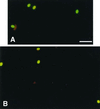One-step purification of Enterocytozoon bieneusi spores from human stools by immunoaffinity expanded-bed adsorption
- PMID: 11326019
- PMCID: PMC88054
- DOI: 10.1128/JCM.39.5.1947-1951.2001
One-step purification of Enterocytozoon bieneusi spores from human stools by immunoaffinity expanded-bed adsorption
Abstract
An original, reliable, and reproducible method for the purification of Enterocytozoon bieneusi spores from human stools is described. We recently reported the production of a species-specific monoclonal antibody (MAb) 6E52D9 immunoglobulin G2a (IgG2a) raised against the exospore of E. bieneusi spore walls. The MAb was used as a ligand to develop an immunoaffinity matrix. The mouse IgG2a MAb was bound directly to a Streamline rProtein A adsorbent, used for expanded-bed adsorption of immunoglobulins, for optimal spatial orientation of the antibody and maximum binding efficiency of the antigen. The complex was then cross-linked covalently using dimethyl pimelimidate dihydrochloride. After incubation of the immunoaffinity matrix with filtered stool samples containing numerous E. bieneusi spores and before elution with 6 M guanidine HCl, the expansion of the adsorbent bed eliminated all the fecal contaminants. The presence of spores in the elution fractions was determined by an indirect immunofluorescence antibody test (IFAT). E. bieneusi spores were found in the elution fraction in all four experiments and were still highly antigenic as indicated by IFAT. Smears examined by light microscopy contained very clean spores with no fecal debris or background bacterial and fungal contaminants. However, spore recovery rates were relatively low: an average of 10(7) spores were purified per run. This technique for isolating E. bieneusi spores directly from human stool samples with a high degree of purity opens up new approaches for studying this parasite.
Figures


References
-
- Ahn M H, Hyun K H, Kang J O, Min D Y. Partially purified Toxoplasma gondii antigens by immunoaffinity chromatography. Korean J Parasitol. 1997;35:251–258. - PubMed
-
- Anastasi J K, Capili B. HIV and diarrhea in the era of HAART: 1998 New York State hospitalizations. Am J Infect Control. 2000;28:262–266. - PubMed
-
- Asmuth D M, DeGirolami P C, Federman M, Ezratty C R, Pleskow D K, Desai G, Wanke C A. Clinical features of microsporidiosis in patients with AIDS. Clin Infect Dis. 1994;18:819–825. - PubMed
-
- Campo-Neto A, Lima F W, Andrade A F. Purification of tissue forms (amastigotes) of Trypanosoma cruzi by immunoaffinity chromatography. J Protozool. 1985;32:84–88. - PubMed
Publication types
MeSH terms
LinkOut - more resources
Full Text Sources
Other Literature Sources
Medical

